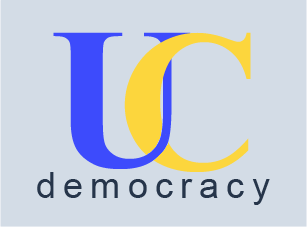
| ABOUT | WHY DEMOCRATIZE? | PROPOSALS | ISSUES & DISCUSSION | NEWS & EVENTS | WHAT YOU CAN DO | LEGISLATION | LINKS & RESOURCES | FAQs | CONTACTS |
| to subscribe to monthly updates, please
Upcoming Events: ** April 24th - 2nd Statewide planning conference, Santee High School, LA ** May 6th - Senate Budget Subcommittee meeting on UC, Sacramento, Room 3191 ** May 13th - 50 years of student activism in the Bay Area, SF City Hall
|
Why Democratize?
|
|
The existing 26-member UC Board of Regents – composed of 18 appointees by the Governor, 1 student, and 7 ex-officio members – is structurally unable to meet today’s challenges of public higher education. The UC system is encountering dramatic inequality, declining support for public services, rapid technological change, and political stalemates, and yet the response by successive Boards has been woefully inadequate. In contrast, new approaches to tackling UC’s challenges require a new, hybrid Board structure that integrates appointees by the Governor and Legislature, ex-officio members, and Regents elected by faculty, staff, and students. This more diverse, accountable array of Regents will provide the skills, energy, insight and responsiveness needed for a world-class, public UC system to flourish in the 21st Century in excellence, access and public service. Only by reforming the Board of Regents will the public have effective means to defend public education. Regents appointed by the Governor have brought UC aloof and bloated administration, inadequate state funding, skyrocketing fees, threats to faculty shared governance, and poor labor relations with staff. Over 40 years have lapsed since the last structural changes in the Board of Regents,the 26-member body that manages the entire University of California system. Current Board structures are hindering the UC system's ability to adapt to challenging times, threatening UC's access, excellence and public service. Widespread concerns about public higher education in the University of California system often focus on disparate symptoms – rising fees, low wages, imperiled pension plans, re-segregation, and management scandals – that nearly all ultimately share common roots in the inappropriate structure and dynamics of the UC Board of Regents. There are at least six key structural flaws in the current design of the Board of Regents that prevent the University of California from achieving its goals of access, excellence and public benefit. There is insufficient representation of UC students, staff and associate and tenured faculty, who are key stakeholders with valuable insight, skills and experience to contribute. The Regents lack clear overarching responsibilities and roles. There are inadequate incentives for Regents to engage with the public and to ensure public views and concerns influence the practices and decisions of the BoR. And excessive term lengths for appointees hinder the ability to ensure that the Board is composed of responsive, competent, engaged, responsible Regents. In addition to these problems in the design of the BoR, there are also flaws in the practices of the Regents, and in the associated processes of selecting Regents. These flaws in practice include a lack of educational experience by Regents, poor attendance, insufficient oversight (on administration, compensation, public engagement, lab management, and environmental impacts), conflicts of interest.
|
